-
Car Reviews
- Car News
-
Car Comparisons
Latest comparisons
- Chasing Deals
Protracted and costly development targeted at Australian driving tastes sees the Kia Tasman debut near the top of the class, but it isn’t a perfect ute
After lengthy deliberations, Kia hit the ‘go’ button on a project to develop and sell a midsize pick-up in 2019. The result of that plan, internally codenamed ‘TK’, is the much-teased Tasman that is now rolling into the South Korean brand’s Australian dealerships.
For years, Kia toyed with the idea of adapting its existing Korean-market ladder-frame platform for a ute mainly designed to tackle the roaring Australian ute market. Locked out of the United States by decades-old pick-up tariffs and with European emissions regulations making utes uncommercial there, ‘TK’ would have to rely on Australian sales.

Internally, the view was that Tasman shouldn’t be done by halves and a plan to save cash by adjusting the existing Kia Mohave 4WD architecture was abandoned in favour of developing a clean-sheet ute design. Immediately pre-COVID, and then as that pandemic took hold globally, the PX Mk III Ford Ranger was benchmarked as the best-in-segment.
Meanwhile, Ford (with co-investment from Volkswagen) was feverishly developing a major Ranger upgrade, expanding its chassis and preparing to install hallmark V6 engines. In the shadows, Chinese rivals Australians had not yet even thought of (such as BYD) were considering their own tilt at the ute market with novel plug-in hybrid powertrains.
As coronavirus raged, Kia engineers plugged away in Korea on a ute that was durable but not well-attuned to Australian roads. As international travel resumed and ‘TK’ prototypes landed for local tuning, considerable suspension re-engineering was determined necessary, knocking back the ute’s launch. Still, Kia knew it had one shot to get the vehicle right.
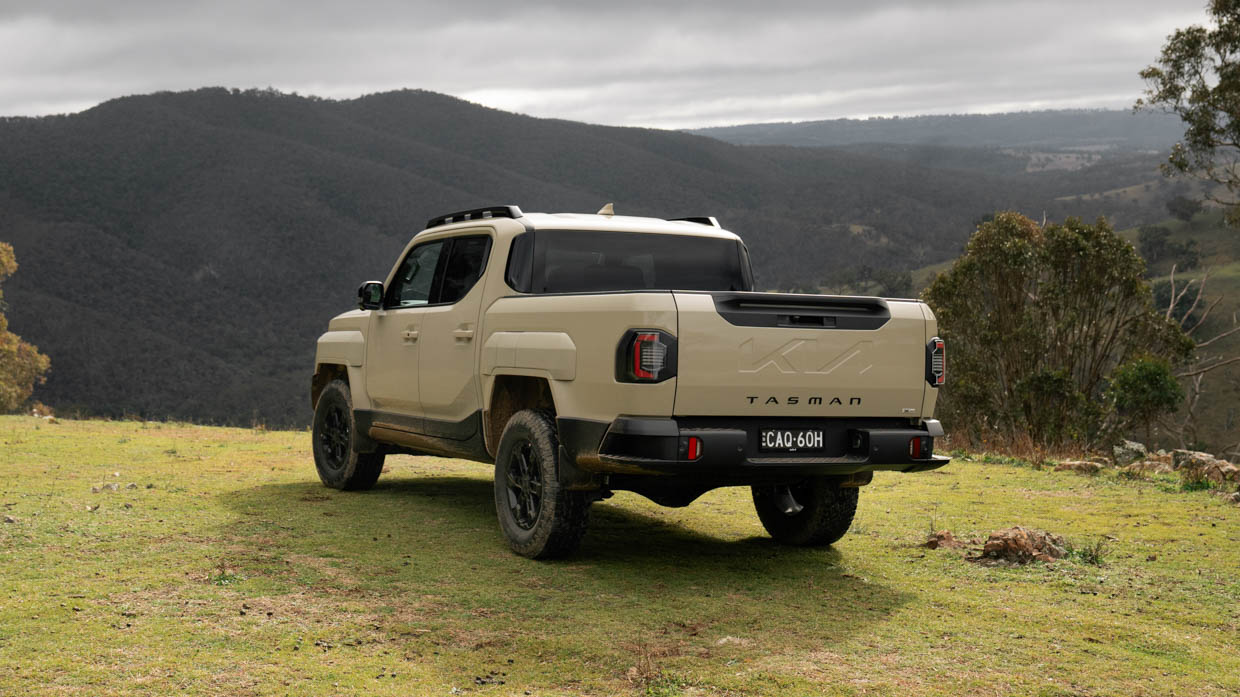
Around the time ‘TK’ needed a name — Kia Tanami was the first choice of local planners, Kia Tasman was the second and successful nomination, accepted by Korea — the Albanese Labor government resolved to proceed with the New Vehicle Emissions Standard (NVES) suite of laws that will penalise, among other things, the sale of high-CO2 diesel utes.
The winter of 2025 — the launch window selected by Kia for the TK Tasman — has been unseasonably cold in southeastern Australia.
It’s been windy, too, with triple headwinds battering Kia: the NVES headache that has made now the worst time in Australian history to launch a diesel ute, China seizing the initiative with low-CO2 hybrid pick-ups that comply with NVES, and the segment-topping and six-cylinder Ranger contest that just won’t go away.
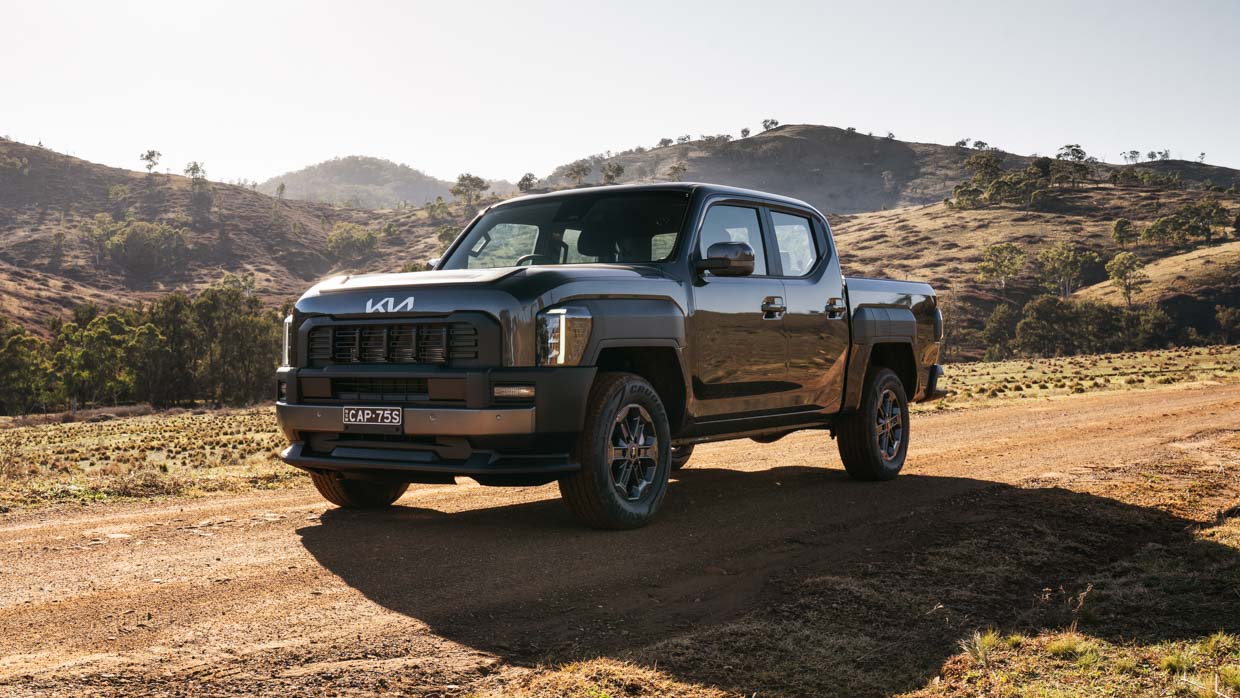
Beneath polarising styling, Tasman arrives packing only a four-cylinder, non-hybrid diesel engine. No V6 is likely. A strong hybrid sits somewhere over the horizon — years away. Tasman’s enormously expensive clean-sheet gestation also means it carries aspirationally high pricing for a vehicle with no established reputation in this country.
Kia says the Tasman is perfectly suited to Australian conditions. It is affirmed by the fact 80 percent of ute buyers still choose four-cylinder diesels. The Korean manufacturer has an expanding suite of EVs it thinks will offset Tasman’s CO2 profile, allowing it to sell in big numbers.
Under the surface, Kia is tough and prepared to fight. In South Korea, Kia builds the military’s tanks and transport vehicles that are ready for war. In Australia, the Tasman’s enemies have more familiar names: Ranger. Toyota HiLux. Even the BYD Shark 6. The goal? One of 20,000 sales in the first year — a result that would be competitive with the Isuzu D-Max.
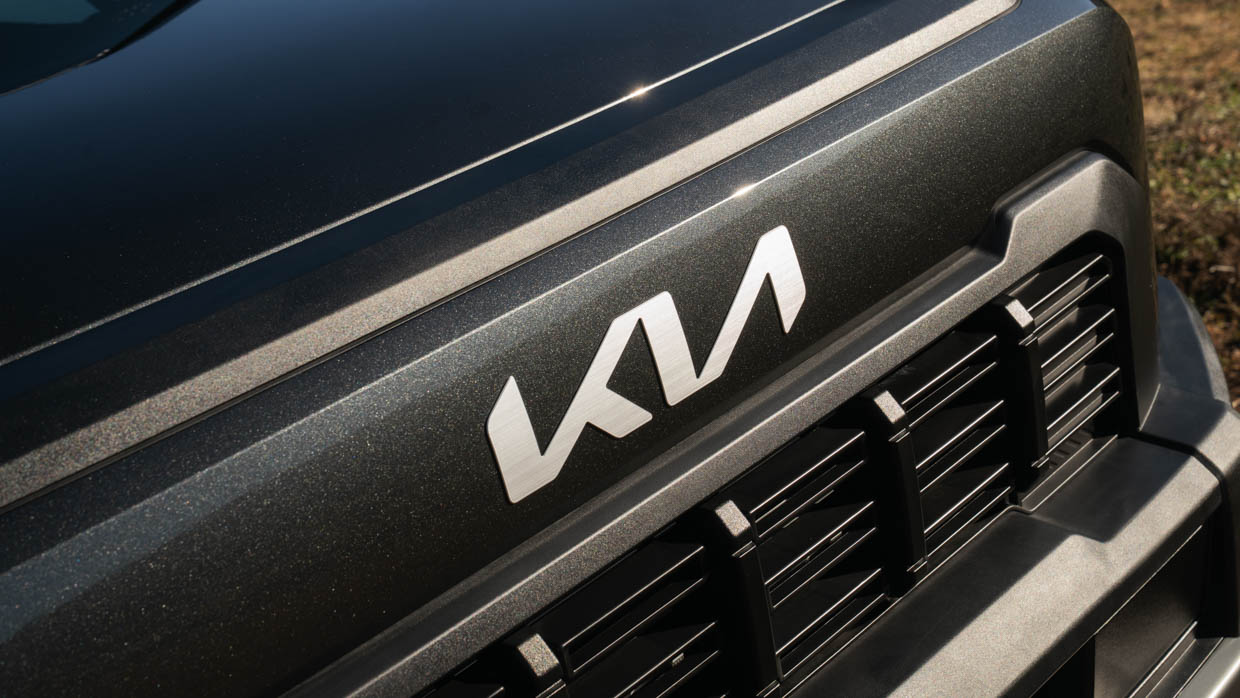
Our first comprehensive Tasman experience was carried out on (and off) the very roads it was tuned on in Australia — in and around Bathurst, Rydal, Sofala and Oberon in New South Wales.
The Tasman is noticeably larger than the average midsize pick-up. In double-cab form, across a five-strong lineup, each grade measures 5410mm in length and 1930mm wide on a 3270mm wheelbase.
Height differences are the giveaway to the different look of various Tasman grades, with fleet-focussed S/SX/SX+ measuring 1870mm high (with 206mm ground clearance), X-Line 1890mm high (224mm clearance), while X-Pro sits much higher at 1920mm (252mm clearance).
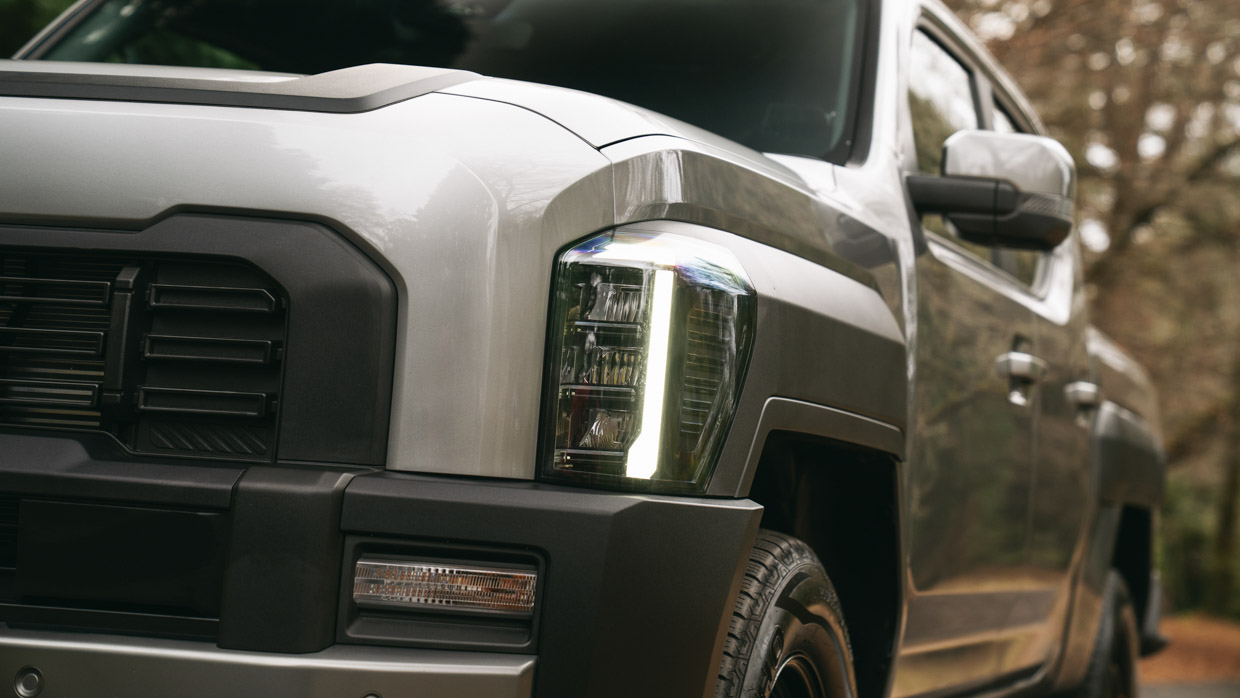
Given Kia’s intention to grab 10 percent of the Australian ute market in short order, it’s no surprise the Tasman lineup is extensive. The double cab version launches with five grades intended to cater to customers ranging from heavy-duty fleet to the luxury/off-roading lifestyle market.
At launch, pricing for the Tasman double-cab lineup comprises manufacturer’s recommended list pricing (MRLP) and also national driveaway offers as below:
At the top end of the Tasman lineup, the launch pricing is relatively similar to the top-selling Ford Ranger, though lower trims of the Tasman are a little cheaper than an equivalent Ranger (or Toyota HiLux).
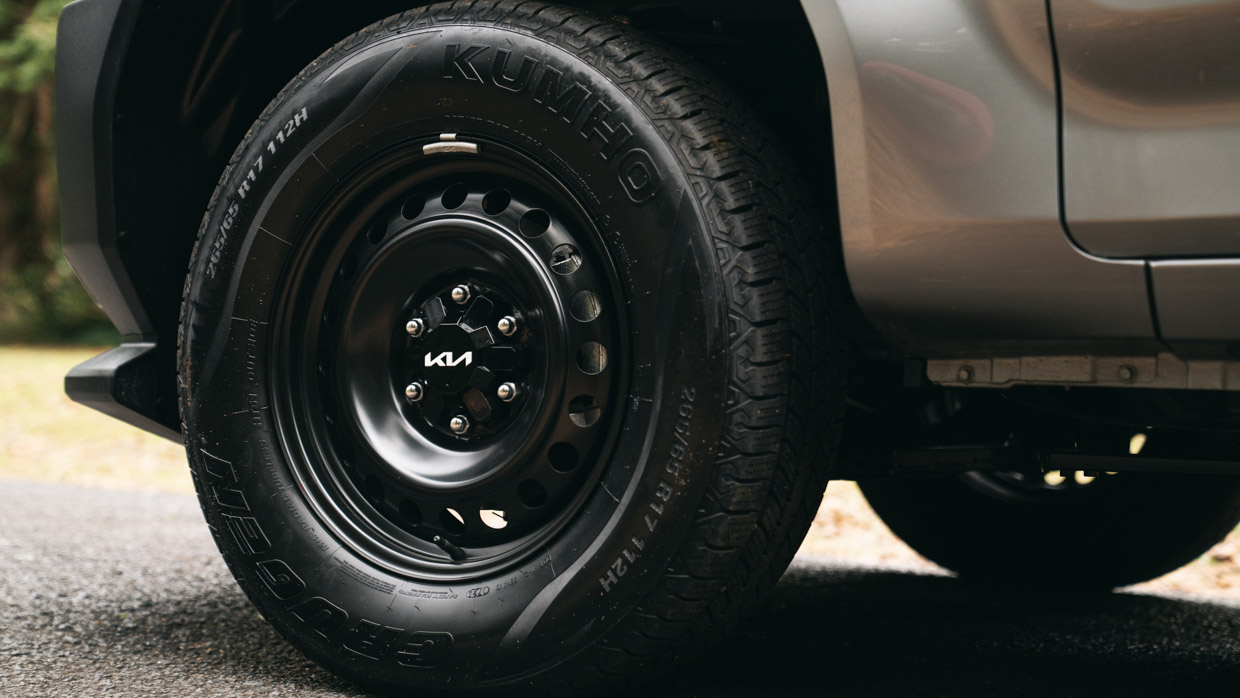
Only the base S can be specified in 4×2 double cab form with 4×4 a hefty $7400 option on that grade. Standard on S are 17-inch steel wheels in 265/65 R17 Kumho tyres, the ‘pedestrian-friendly’ front end design with low scoop, LED MFR headlights, smart key with remote engine start, tyre pressure monitoring and Kia Connect online features.
Other base inclusions are manual cloth seats up front, tip-up second row seats with storage boxes, faux leather steering wheel and gear shifter, twin 12.3-inch displays (with wireless Apple CarPlay/Android Auto), two front USB-C ports, an AM/FM/DAB radio, and dual-zone climate control.
Opting for the tier-two ($58,490) SX costs $4600 and adds just a few niceties. Notably SX does not look like a base model (thanks to its grey 17-inch alloy wheels rather than steelies); other additions are integrated satellite navigation, a highway driving assistant, and additional colour options bringing Tan Beige and Denim Blue to the paint list.
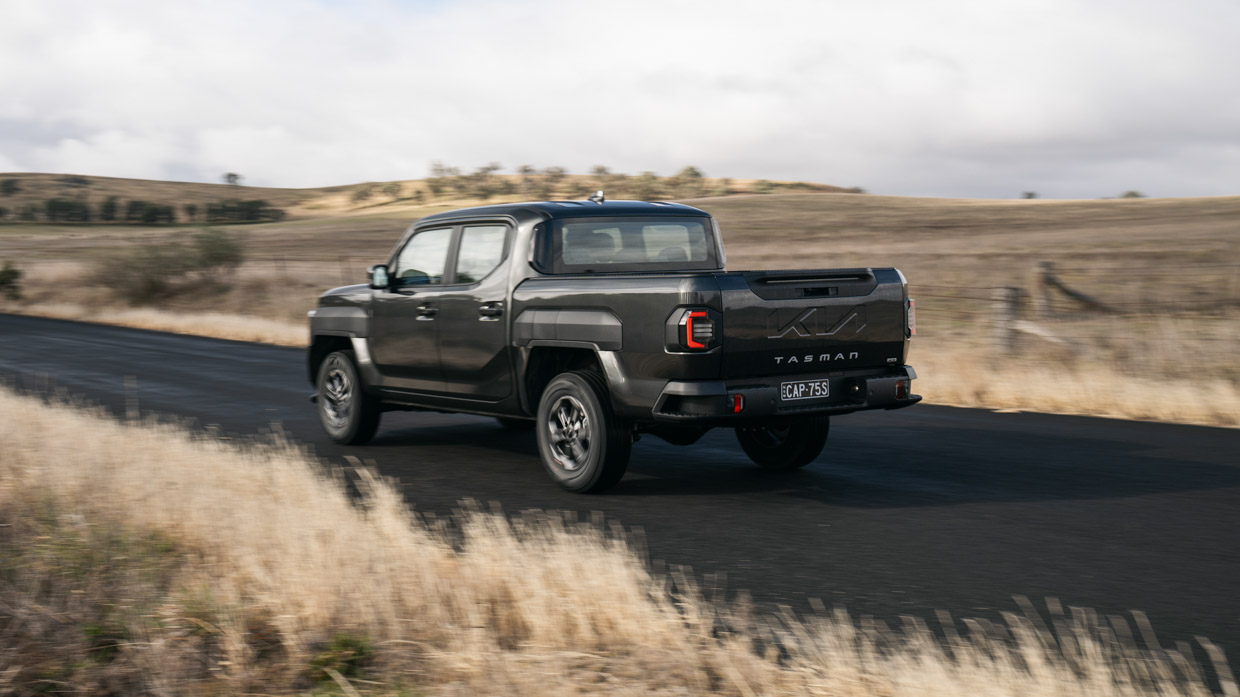
Splashing a further $8000 buys the $66,490 SX+, which steps spec up to include machined 18-inch alloys in 265/60 R18 Kumhos, LED fog lights, a lined and lit tub, two 240-volt power outlets, LED tail-lights, cloth/artificial leather seat upholstery, back seat air vents, a wireless device charger, power folding side mirrors, zippered seatback pockets, and mud guards.
From there, it’s a literal step up into the higher-riding ‘X-series’ trims. Intended for the lifestyle market rather than fleets, these versions go without the ANCAP five-star crash rating (as they lack some pedestrian protection mandated from 2025), have more rugged exterior styling and higher ground clearance.
The $70,990 X-Line is just $4500 more than an SX+ but adds substantial spec in the form of roof rails, privacy glass, an acoustic windscreen, 360-degree camera, rear fender flare storage, artificial leather upholstery, a 10-way power driver’s seat, heated front seats, upgraded tilt/slide rear seats, tub cleats, dual wireless chargers and a folding front table.
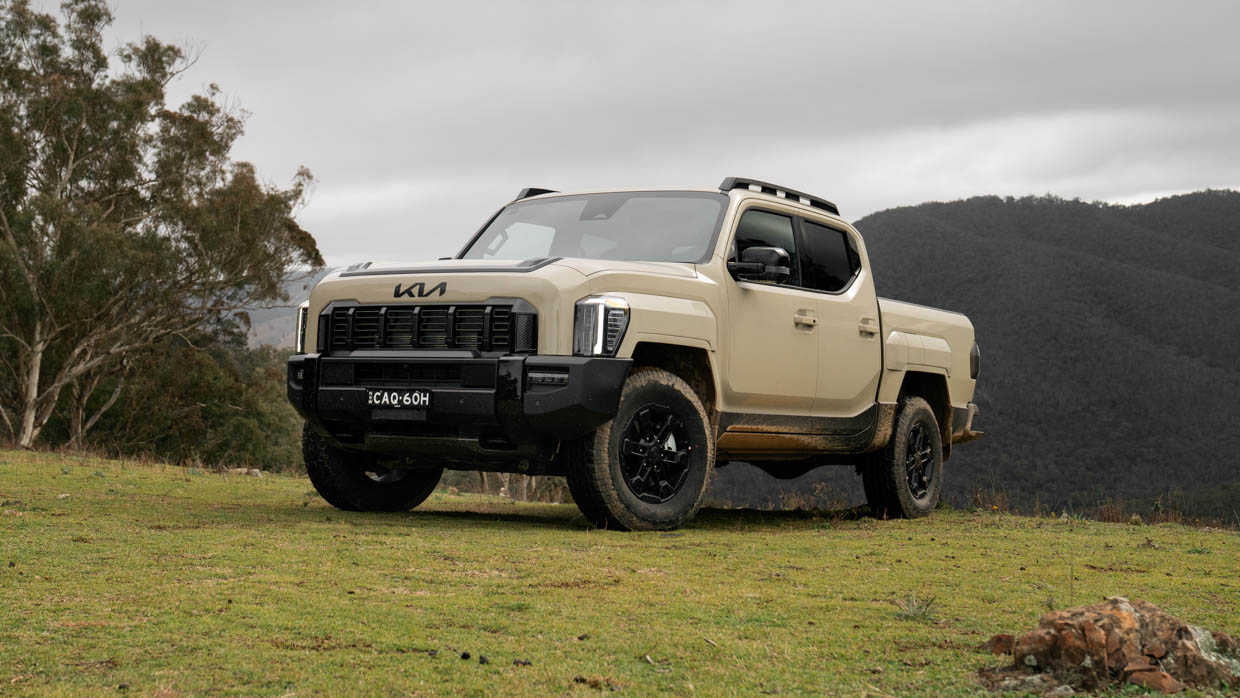
Other X-Line goodies include a dual glovebox, automated parking, puddle lamps, two second-row USB-C ports, and a centre console layout unique to the X-series models that relocates the shifter to the column to create more storage space.
Finally, the $77,990 X-Pro is the range-topping Tasman and the only one really intended for off-roading from the showroom floor. It downsizes from 18s to black 17-inch alloys wrapped in 265/70 R17 Hankook all-terrain tyres while adding a ground view monitor and an off-road data page in the infotainment system.
The X-Pro also scores additional luxuries in the form of a 10-way power passenger seat, memory for the driver, an opening sunroof, heated steering wheel, cooled front seats, heated second row seats, an eight-speaker Harman-Kardon stereo, and auto-dipping for the side mirrors when reverse is selected.
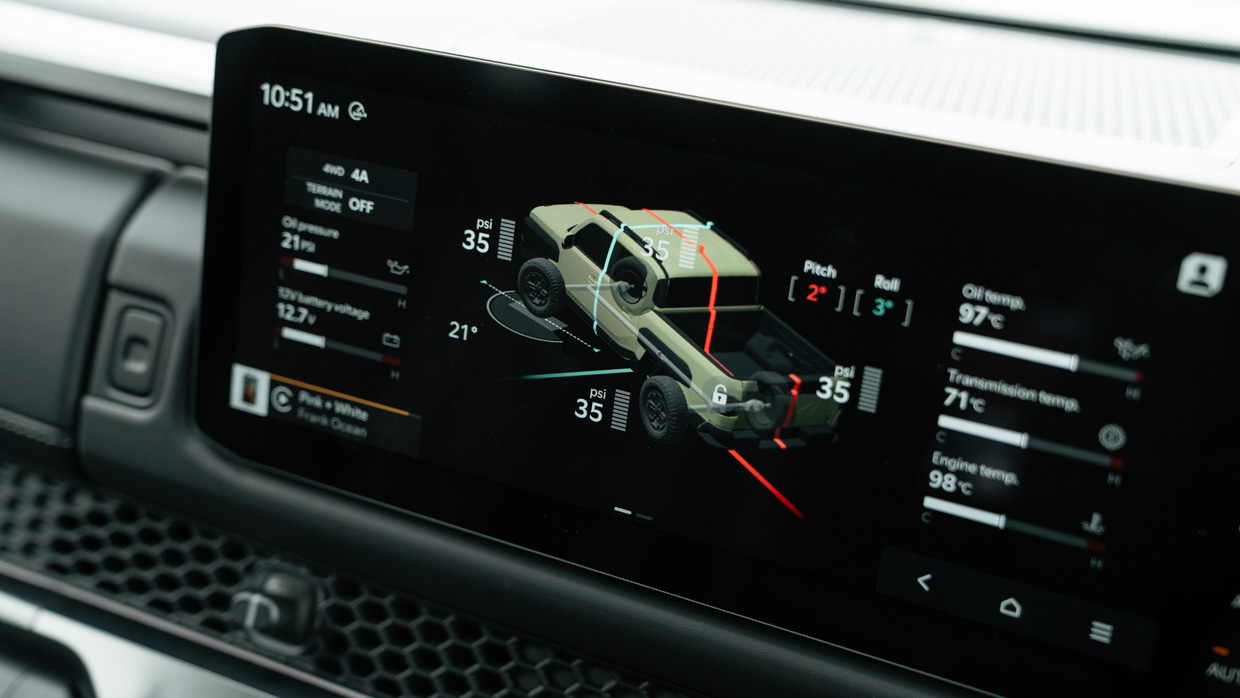
A full-size alloy spare wheel is standard across the range, as is forwards autonomous emergency braking (AEB), a reversing camera, adaptive cruise control and lane keep assist. Disappointingly, reversing AEB — which can detect objects behind a reversing vehicle and stop it automatically — only becomes standard on the pricey X-Line.
Each Tasman grade can be specified with circa-one tonne or circa-900kg payload, with operators and buyers expected to choose the most tax-efficient configuration for them.
One-tonne versions have a gross vehicle mass (GVM) of 3250kg and gross combination mass (GCM) of a relatively low 6200kg. When not towing, payload is 1013–1124kg depending on variant. Max out, the Tasman’s rated 3500kg braked towing limit (with a 350kg tow bar download) and remaining legal payload gets very low indeed.
The high development cost and long lifespan of utes means it’s a treat to drive a pick-up that is genuinely brand new. With Tasman, the ladder frame is a clean-sheet design and the suspension is bespoke.
Kia Australia engineers exerted strong influence over the design of the suspension and steering in a bid to make the Tasman one of the best utes to drive on-road, while retaining a core degree of off-roading ability (particularly in the highest-riding X-Pro variant).
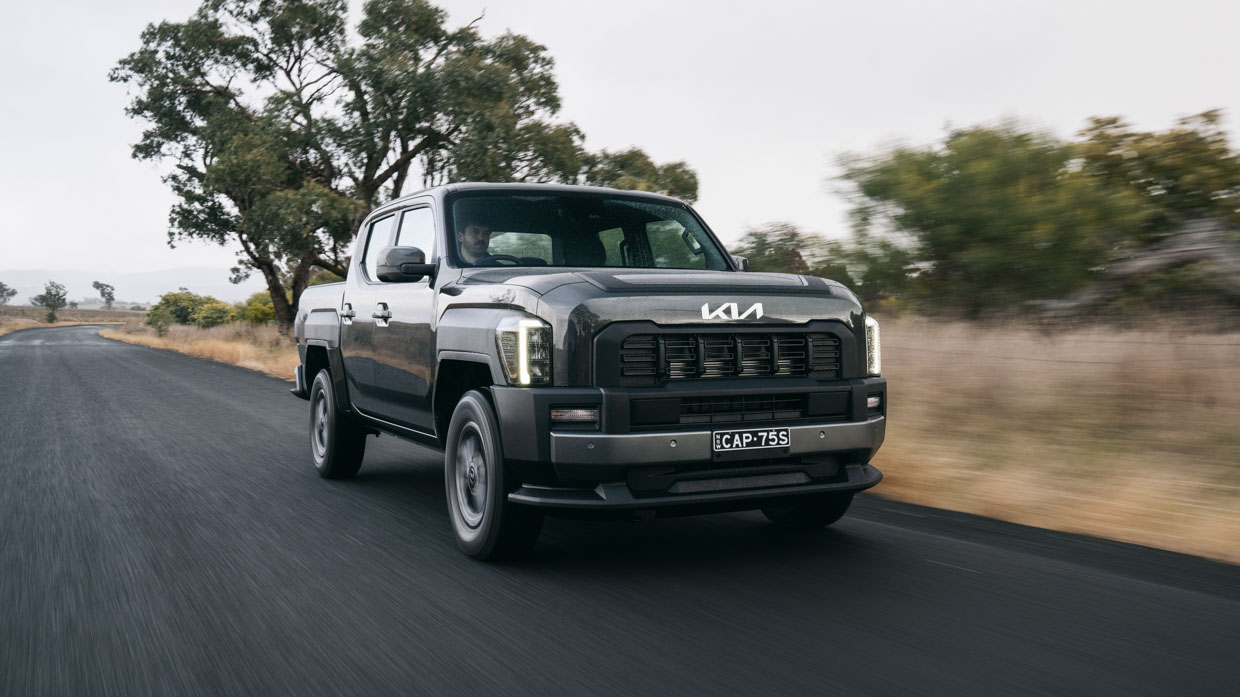
The suspension tune reached by Korean teams during the COVID period was judged too far towards firmness and a major adjustment to the leaf springs was conducted on the back of prototype/rival benchmarking in Australia in 2022.
Sophisticated ZF Sachs frequency-selective dampers are used front and rear, allowing for a 30-40 percent degree of passive adjustability for different road types. Unladen ride quality is a touch firm in the city, but the Tasman’s gait becomes relaxed and flowing as road speeds increase. On country roads, the ride comfort is among the best in the segment.
The suspension is, typically for a ute, a double-wishbone front and leaf-sprung rear design, with Kia Australia successfully arguing the case away from single-rate to triple-rate springs, which required expensive changes to the hard points of the Tasman during development.
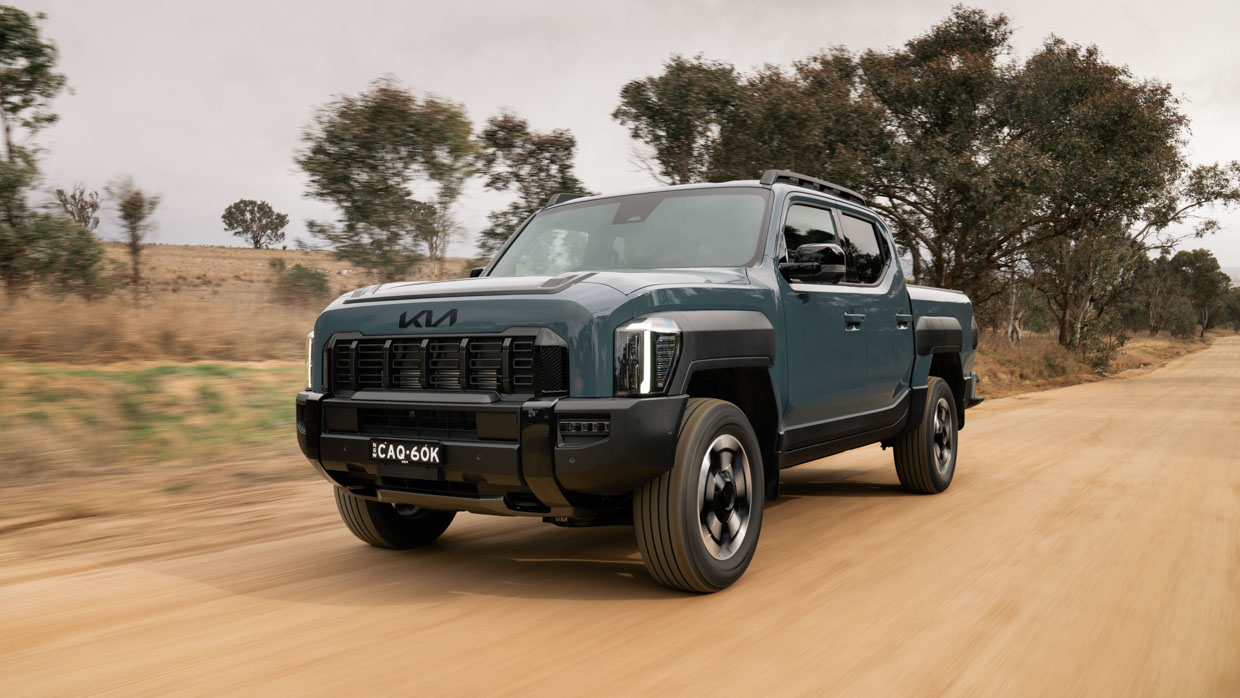
Bump absorption over really rough roads is a standout, both due to decent wheel travel and appropriate spring rates, but also due to the fitment of hydraulic rebound stops which deflect away the thunking effect of topping out the suspension over crests.
Unlike Kia’s SUVs, the Tasman’s steering rack is mounted in rubber to reduce the effect of frame vibrations. This dulls road feel, which has been ‘replaced’ through a remarkably competent electric power steering tune that feels crossover-like and reasonably direct. Like a T6.2 Ranger or Amarok, the Tasman feels quite poised and involving in the corners.
We have seen some of the other components used by the Tasman before: in particular, the inline four-cylinder, single-turbo diesel ‘Smartstream’ 2.2-litre engine is familiar from the Kia Sorento and the old Hyundai Santa Fe.
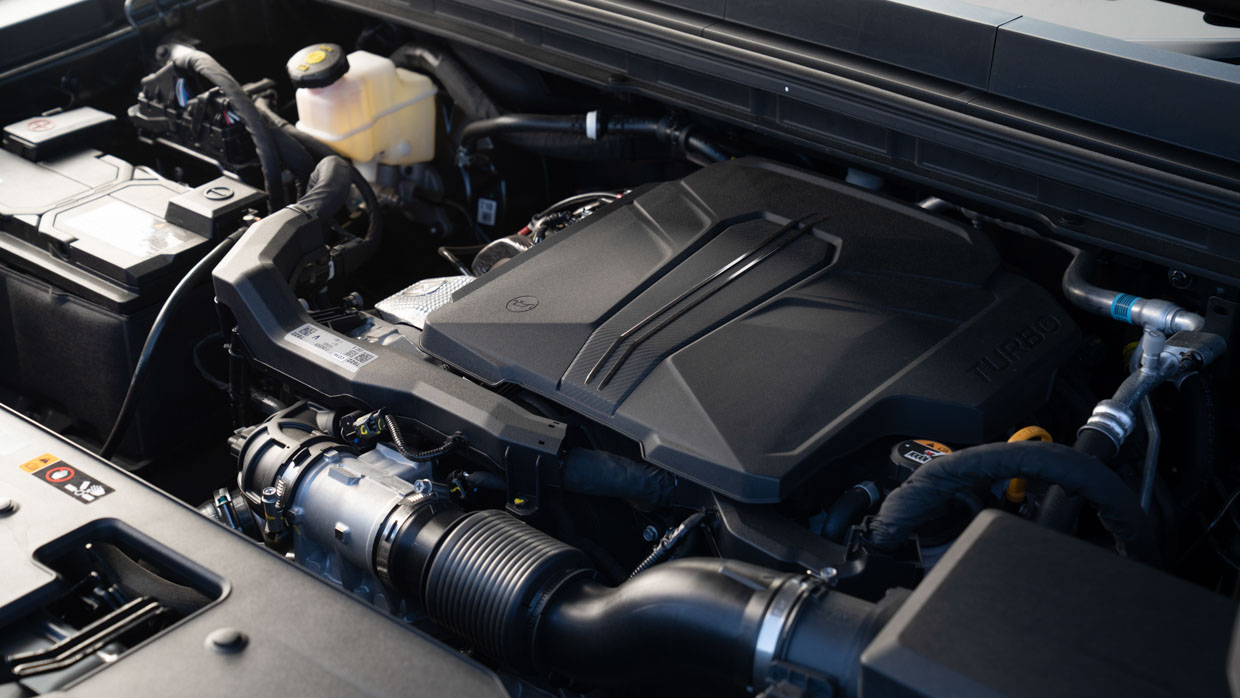
Given how much Kia has invested to ensure that the Tasman sits in the top third of the ute segment for sophisticated ride and handling, it is something of a head-scratcher that the powertrain did not get more attention.
With outputs of 154kW of power and 440Nm, the in-house diesel ‘four is competent and reasonably refined, but it does not stand out from the crowd of similar offers, most of which have more peak torque — HiLux and Ranger each have 500Nm in four-cylinder format.
Kia points out that the Tasman continues to generate at least 400Nm for longer across the rev range than its rivals, and that flexibility does translate to the driving experience. The Tasman feels muscular and quiet…enough.
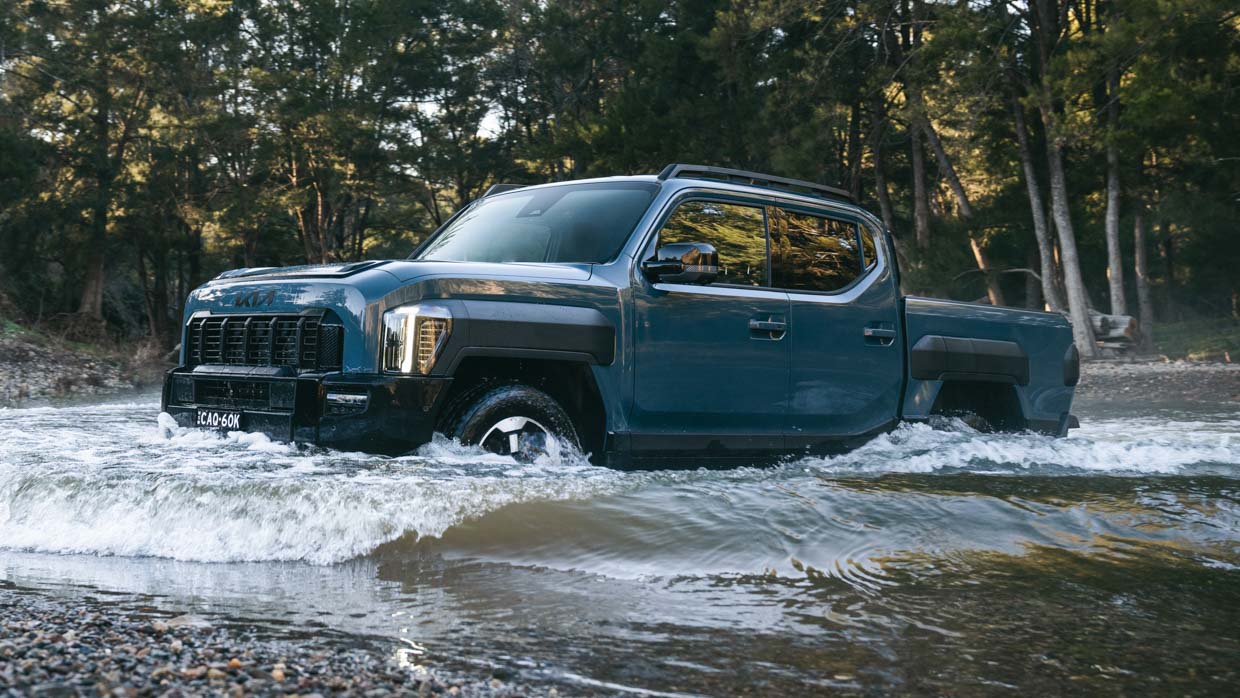
However, the Tasman’s driveline is well off the pace of the performance and refinement of premium engines in the segment — both with regard to the Ranger/Amarok 3.0-litre diesel V6 (184kW/600Nm), or emerging plug-in hybrid (PHEV) options like the imperfect but interesting BYD Shark 6 (321kW/650Nm).
What’s more, a premium engine is not immediately forthcoming for the Tasman. The 2.2-litre diesel is planned to do the heavy lifting until perhaps 2027 when a mild hybrid system may be added, with a stronger degree of hybridisation later still. A fully-electric Tasman is in development but is understood to have been deferred for now.
Making up for some of the four-cylinder’s performance shortcoming is the well-calibrated eight-speed torque converter automatic transmission, which was adapted from the Stinger sports sedan. It’s a busy unit, shifting regularly to keep the diesel engine in its sweet spot.
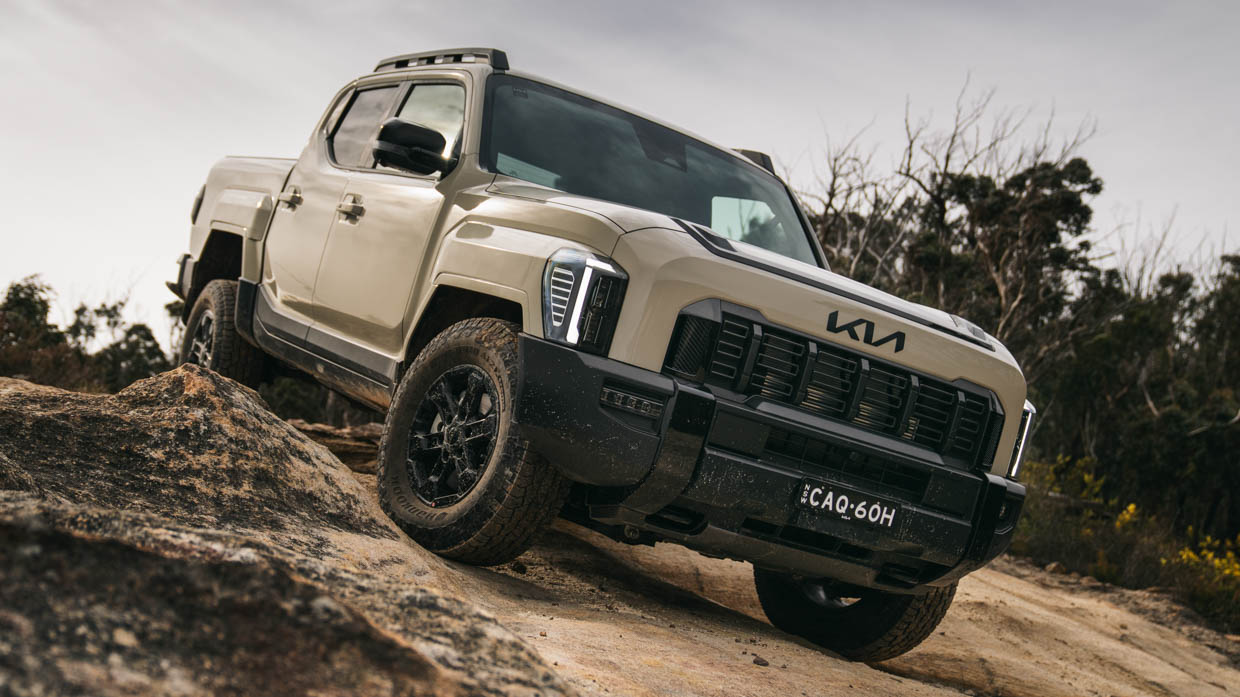
Off-road, there is a marked difference in capability between the fleet-oriented S/SX/SX+ versions, which are hobbled off the blacktop by their low-set pedestrian safety scoop that reduces approach angles from as high as 32 degrees (X-Pro) to just 20deg. Breakover angles are 23-25deg, with departure ranging from 25-26deg across the range.
The X-Pro is the Tasman to buy for out-of-the-box off-roading suitability — not just due to its Kumho all-terrain tyres and 252mm ground clearance, but also its Eaton electromechanical locking rear differential, though all Tasmans have automatic clutch-pack lock at the rear when one wheel overspeeds the other by 125rpm, providing a subtle LSD effect.
Inclusion of a Toyota Crawl Control-esque off-roading system called X-Trek in Kia parlance worked well through five steps of low speed during both descents and ascents, while the fitment (to X-Pro only) of a ground view monitor helps understand what is happening during steep climbs. Wading depth is 800mm across the range.
If the Tasman’s dynamics are a mixed bag (ride and handling good; engine middling), there is no such split of opinion as far as the interior is concerned. Kia has knocked the cabin design of ‘TK’ out of the park in a segment generally known for rough-and-ready durability over plush luxury.
That’s not to say the Kia is glitzy and flimsy. In the face of new Chinese ute competition layering on a ‘veneer of luxury’, the Tasman splits the difference materially between a Ranger and Shark 6 with a deft and considered touch.
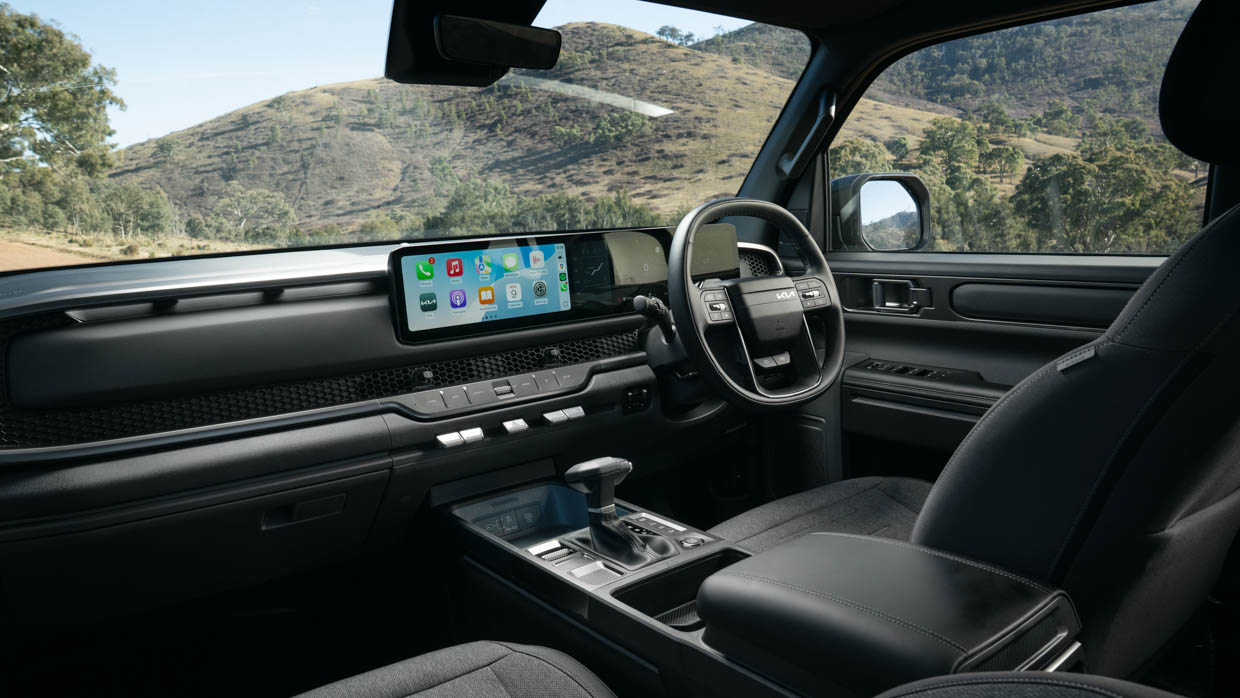
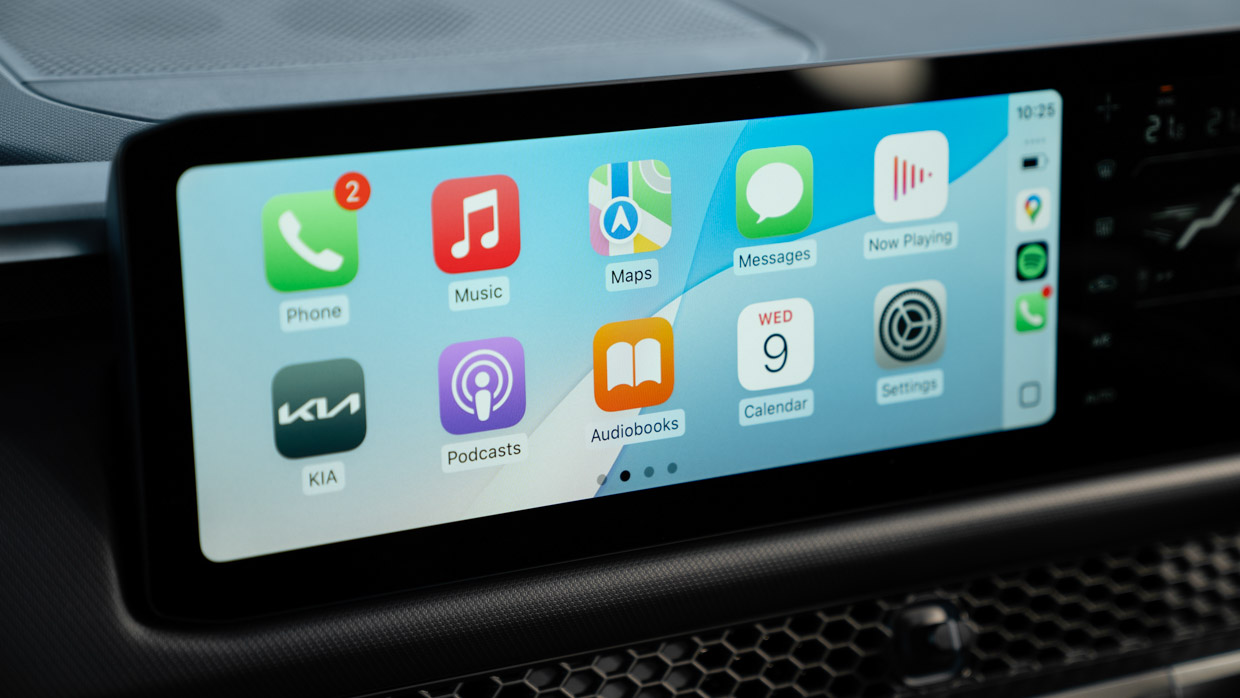
Visually, the Tasman cabin doesn’t look as fancy as that BYD, or a (larger) GWM Cannon Alpha; instead, the aesthetic is handsome and understated. The materials are not luxurious for the sake of it; nor agricultural. Instead, they feel a little special but still hard-wearing — not too far off, for instance, the old Volkswagen Amarok.
Impressively, all Tasmans share a basic dashboard layout incorporating bright, crisp dual 12.3-inch screens, up-to-date with wireless smartphone mirroring, USB-C connectivity and Kia Connect functionality with remote start, locking, climate, and over-the-air updating.
No Tasman has a poxy plastic steering wheel — or leather, for that matter; unnamed ‘premium’ material covers the wheel and shifter across the range. The seats, too, have cloth (S/SX) or various degrees of artificial leather for higher-tier models. Ascending the range sees manual adjustment give way to power, lumbar, memory, heating and even cooling.
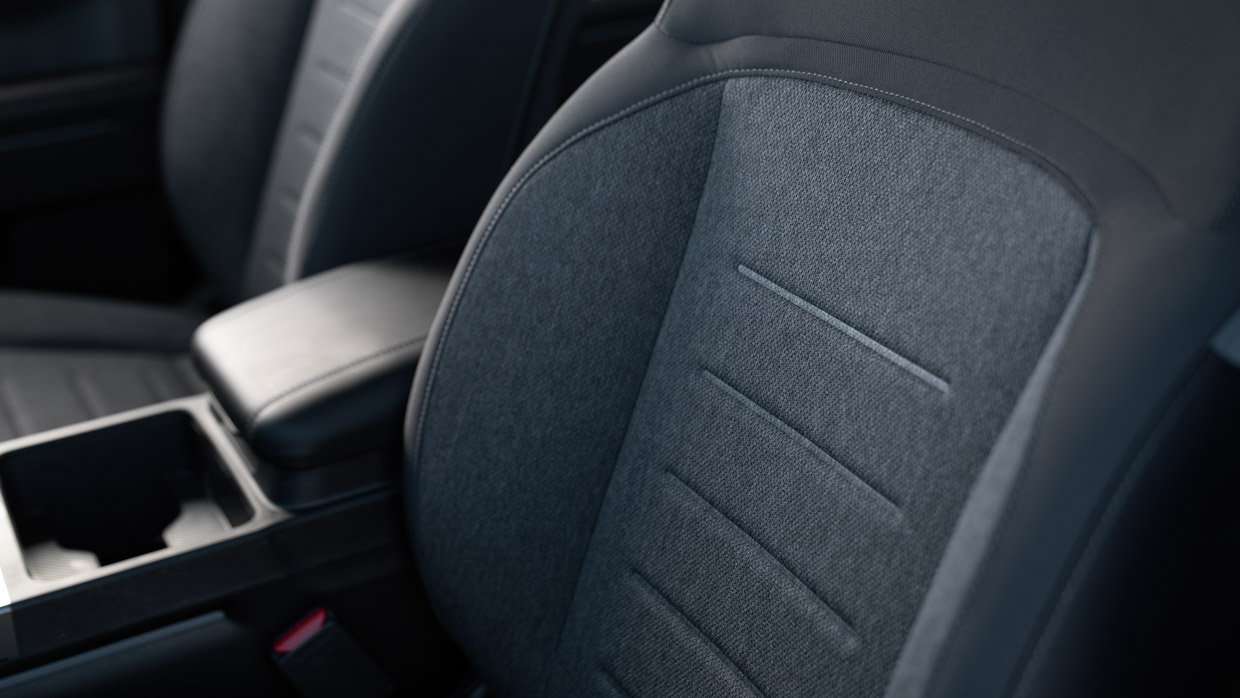
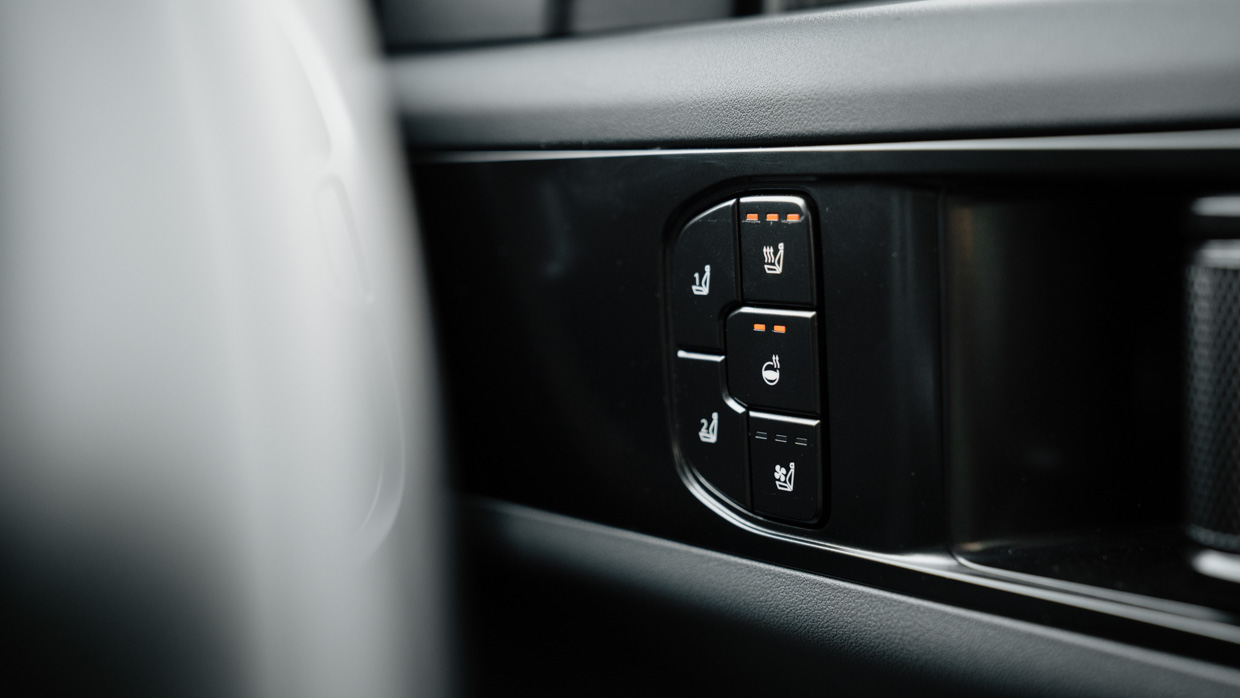
Both the previous- and current-gen Amarok continue to have more comfortable seats than a Tasman, and it was a head-scratcher to hear Kia executives claim the Isuzu D-Max was benchmarked as having the best seats in the class; still, seat comfort in the Kia is reasonable enough.
On-board software works well and ergonomics are a strong point, with steering wheel, stalks and key controls falling to hand while mechanical toggles have been retained for things like temperature and fan speed.
Oddment storage is a standout, though the X-Line/X-Pro grades, which have a different centre console with twin wireless chargers and more space to stash clutter, are the pick for daily workability. The X-series models also pack a trick centre armrest that unfolds forwards to reveal a sturdy table: perfect for a laptop or lunch.
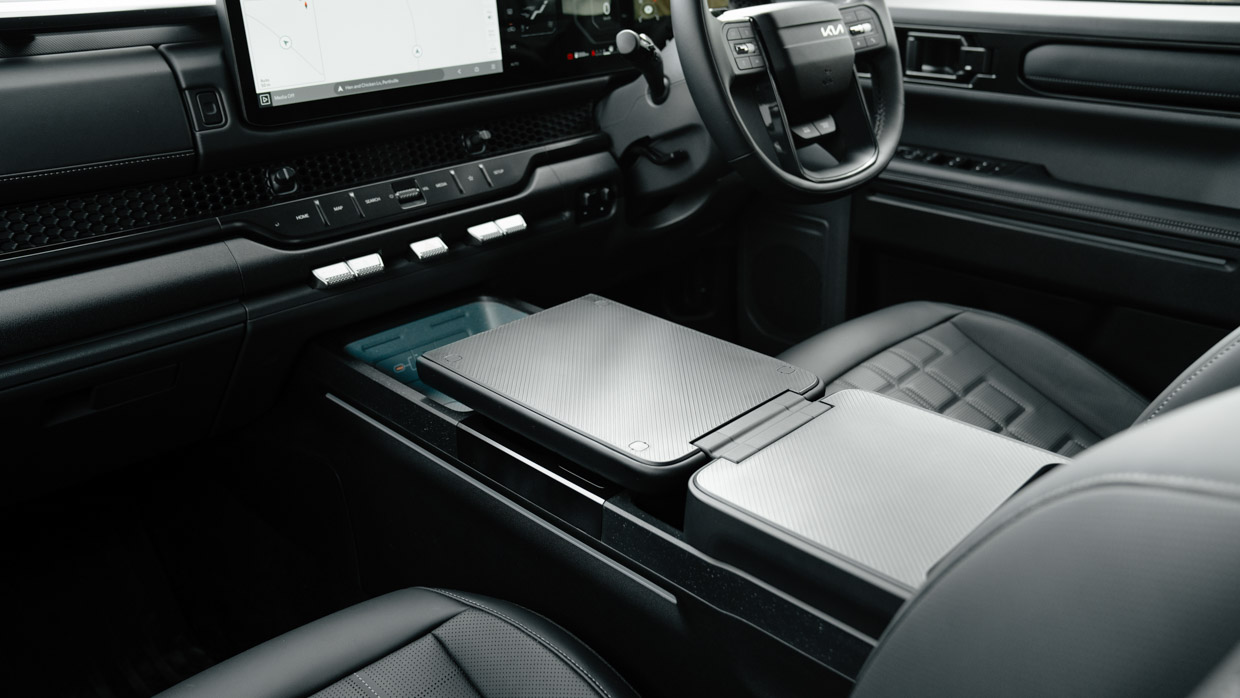
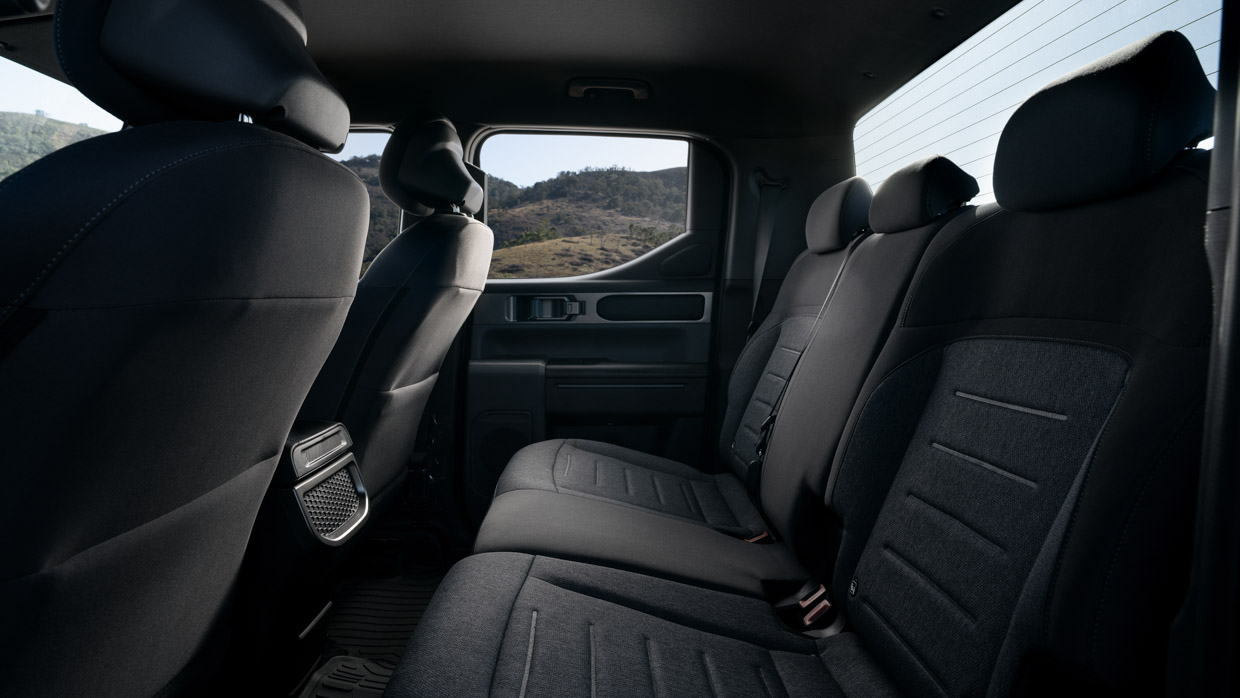
While the X-Pro grade is expensive at $78K on-road, it does feel half a segment above key rivals like the Ranger Wildtrak when it comes to little luxuries — a power sunroof, quality Harman-Kardon stereo, ventilated seats, dual chargers…it’s SUV-like in here. Even the more spartan base grades still feel way more special than a HiLux Workmate…
Two back seat designs are offered, each a bench with three seats. The S/SX/SX+ have a conventional layout, though the seat bases lift to reveal storage beneath.
X-series versions have a slide/recline feature for the rear seats, plus rear air vents (which should really be standard range-wide) plus a centre armrest.
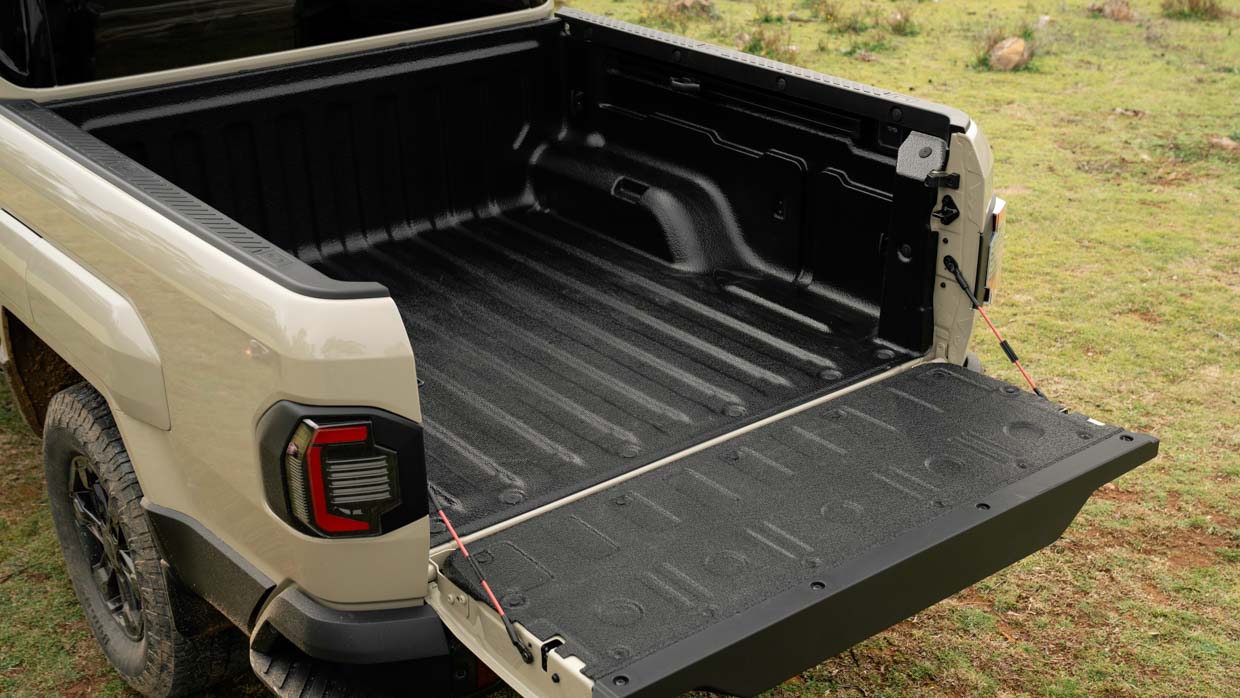
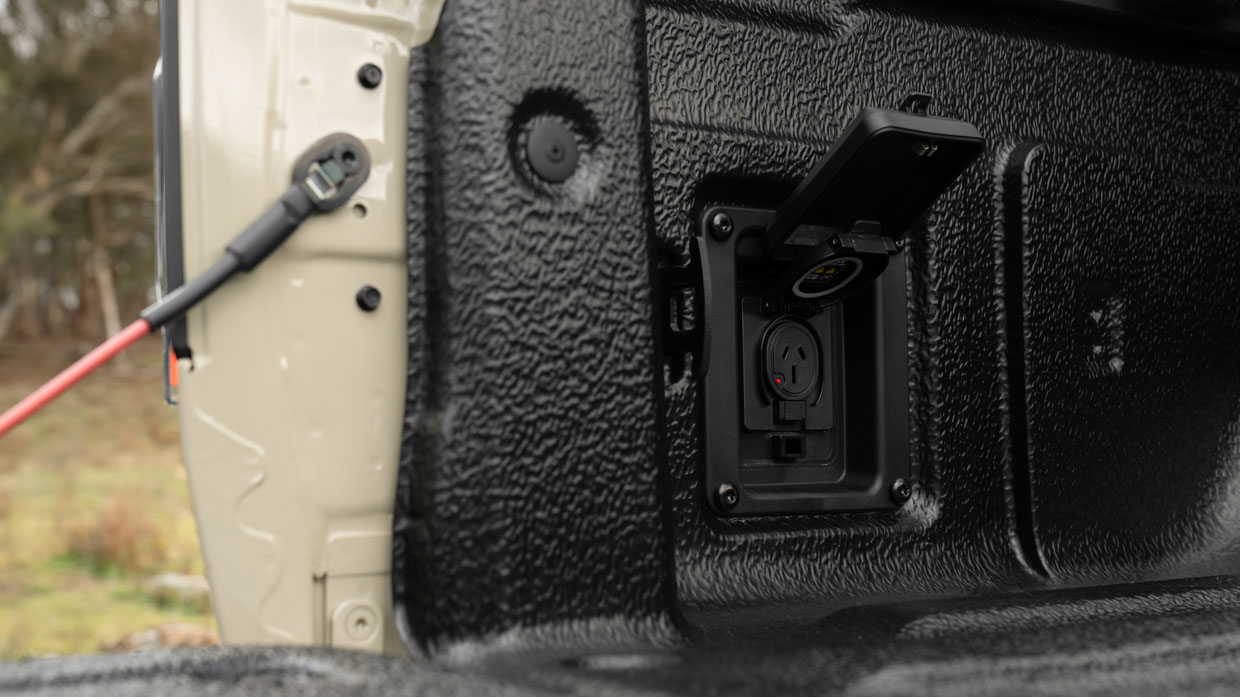
The tub fits a standard Australian pallet (at the insistence of Kia’s local engineers). Length measures in at 1573mm in S/SX (1512mm in SX+ and beyond); width 1600/1572mm, and height 543/540mm. Ranger-esque corner steps up into the tub are standard range-wide.
An unexpected controversy accompanied the release of the Kia Tasman’s 2025-stamped, five-star crash and safety result from ANCAP. It’s this: only the S/SX/SX+ carry the five-star rating. Due to a loophole in ANCAP’s system, the X-Line and X-Pro are ‘unrated’.
ANCAP scoring gets harder over time and, from 2025, utes need to account more for pedestrian safety in order to score five stars, which is why the fleet- and road-focussed S/SX/SX+ have an odd, low-set front scoop that makes them look dowdy and substantially compromises their off-road ability.
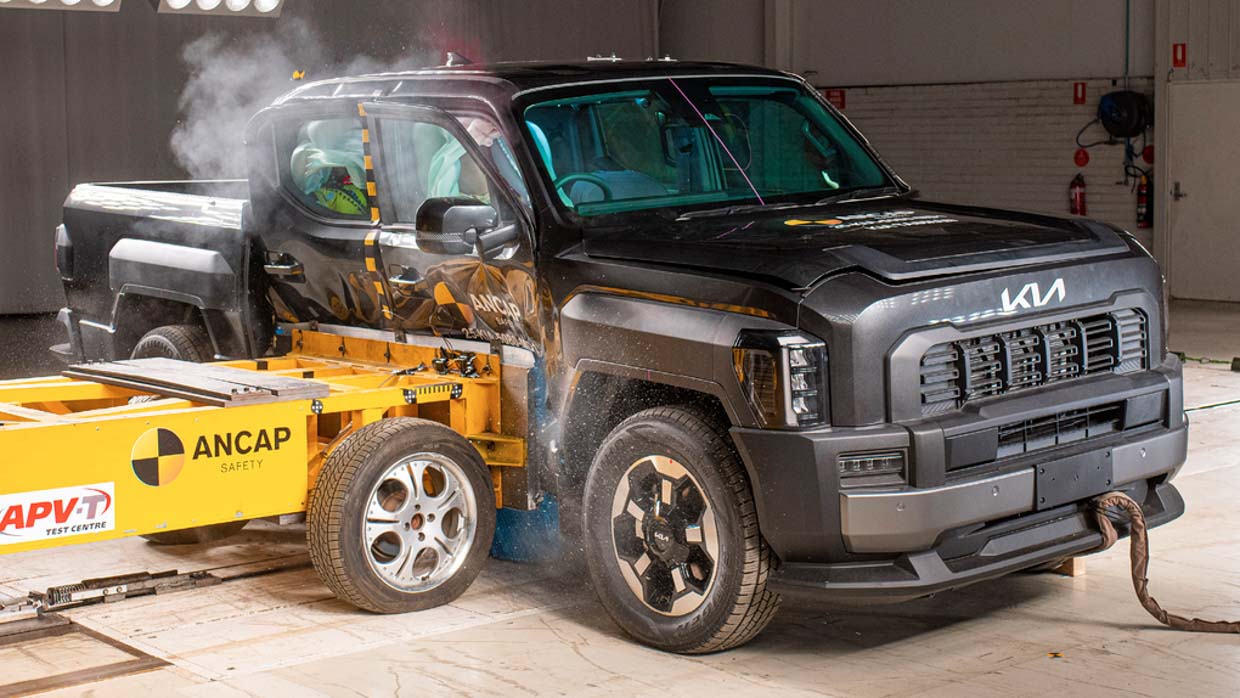
Meanwhile, the honkin’ X-Line and X-Pro go without this scoop and look the way a double-cab four-wheel-drive ute should from front and side on.
Disappointing to us is that some important safety features are reserved for the X-Line and X-Pro, including reversing AEB, but also a 360-degree parking camera, blind spot view cameras, superior headlight technology, and side parking sensors.
Standard range-wide are a reversing camera, front/rear parking sensors, forwards/junction AEB, blind spot monitoring sensors, lane keeping and lane following assistance, driver attention monitoring, speed limit warning, E-call with SOS, and trailer stability assist.
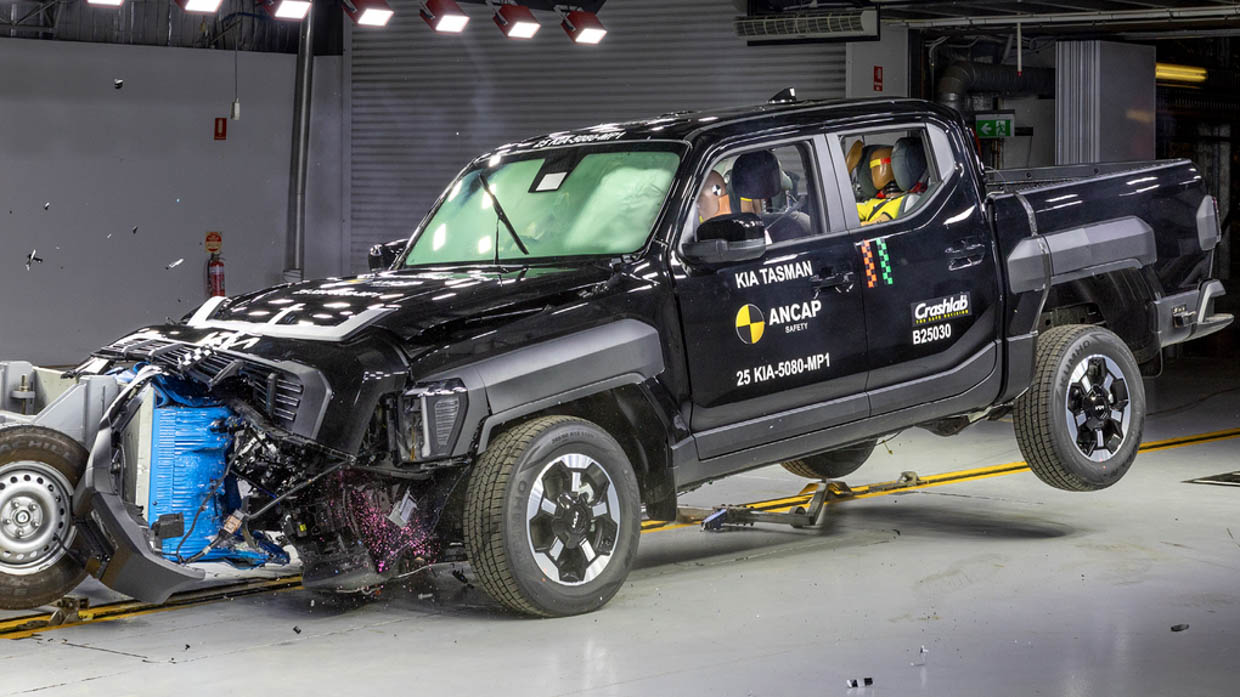
SX trim picks up more sophisticated highway cruise control/lane centring called Highway Drive Assist 2, while the SX+ gains an electrochromic rear mirror that is easier to see at night. The tuning of some of the Tasman’s safety suite was easily better than most utes, with notable smoothness to the cruise control and lane keeping on highway stretches.
Speed monitoring beeps and bongs can be silenced by a long press of the mute button on the steering wheel, but the driver attention monitoring returns with every ignition and is oversensitive.
An upside of the Tasman’s middling performance is that it’s reasonably fuel-efficient — certainly more so than a Ranger V6 or Amarok V6, and is competitive with four-cylinder versions of those utes. You’d hope so!
Kia claims diesel economy of 7.4L/100km (SX 4×2), 7.6L/100km (S 4×4 to SX+), 7.8L/100km (X-Line), and 8.1L/100km (X-Pro) with associated CO2 emissions of between 195-214g/km.
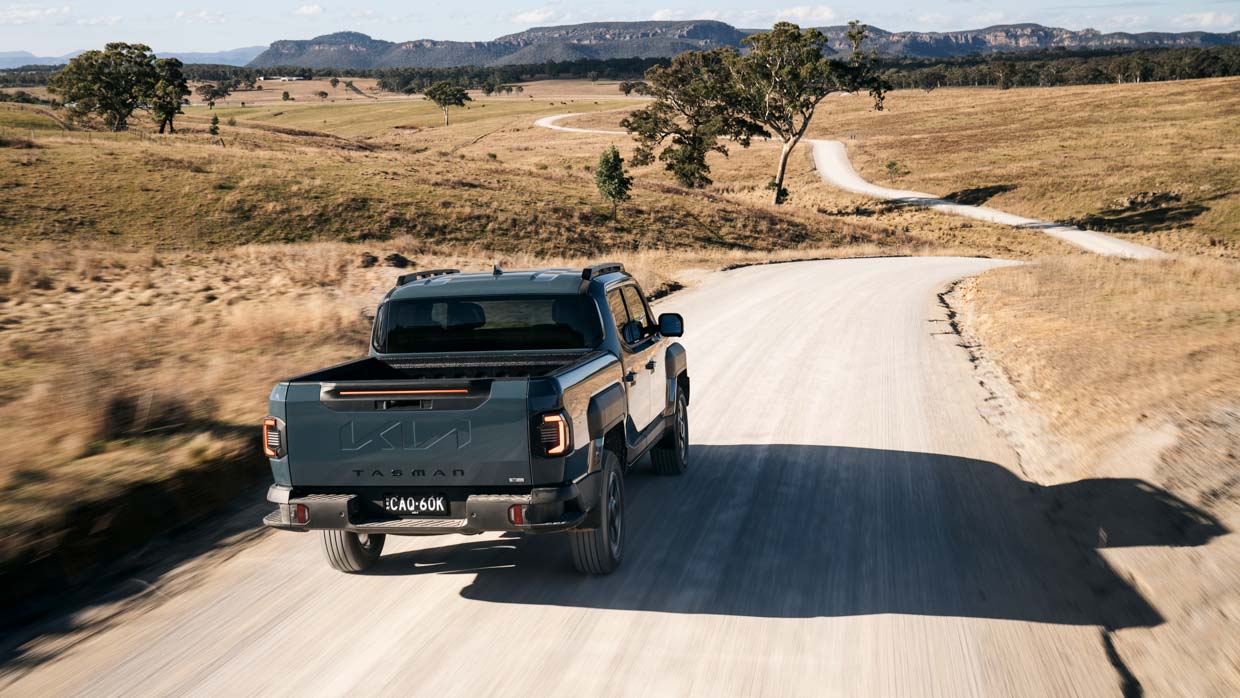
From 2026, the Tasman will no longer be compliant with NVES emissions laws and Kia Australia will need to offset this with greater sales of hybrid and EV models to avoid paying emissions penalties in this country.
On our extensive drive which included around 10 percent urban driving in Bathurst, 60 percent country road driving, and 30 percent freeway, we managed 8.2L/100km in the SX grade — just seven percent more than the combined claim.
From the Tasman’s 80-litre fuel tank, our realistic range would have been 975km which is reasonably flexible for this segment. A DPF is fitted to the vehicle. AdBlue is not required.
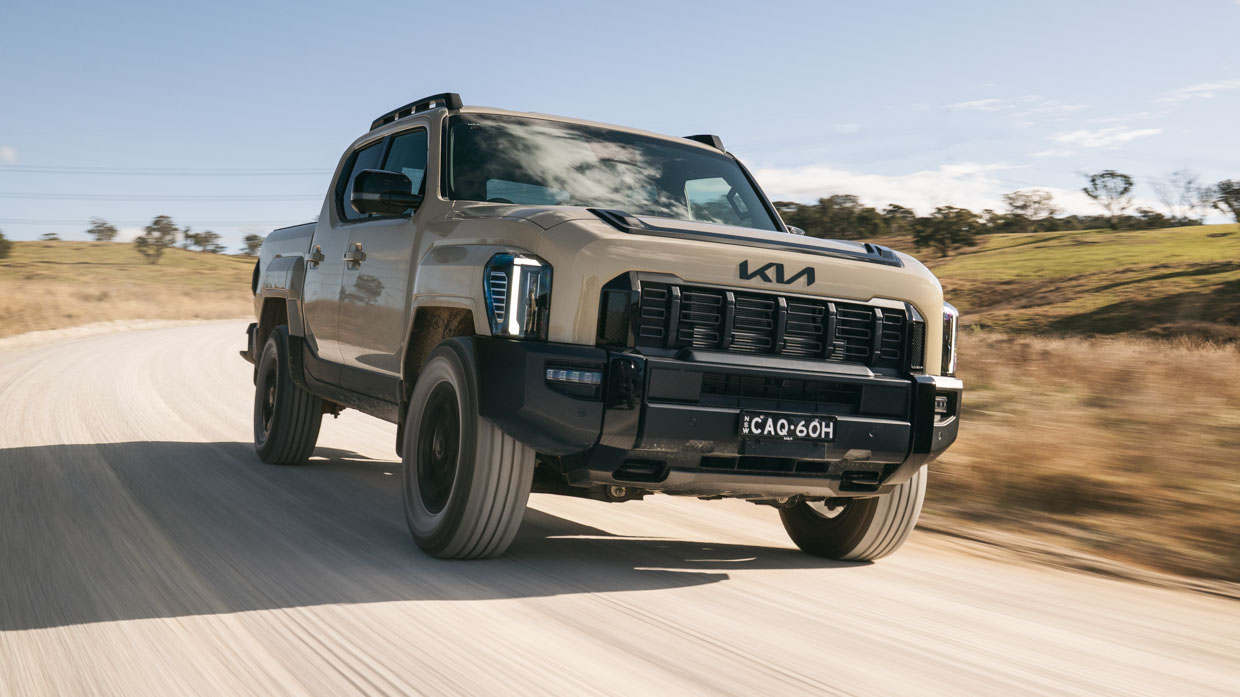
Scheduled maintenance intervals are every 12 months/15,000km for the Tasman. Capped price servicing is offered for seven years, at a five-year cost of $2928 for X-Pro, or $2897 for non-X-Pro 4×4 versions. The S 4×2 costs $2806 to service over the same period.
Warranty is seven years with unlimited kilometres, including for private, general fleet, and government vehicles.
You can tell Kia put a great deal of time into developing the Tasman. It studied its rivals closely and determined what it would need to succeed in the segment. The execution of the Tasman is genuinely impressive for a first-time effort.
Tasman has sailed directly into the top third of the ute segment on debut.
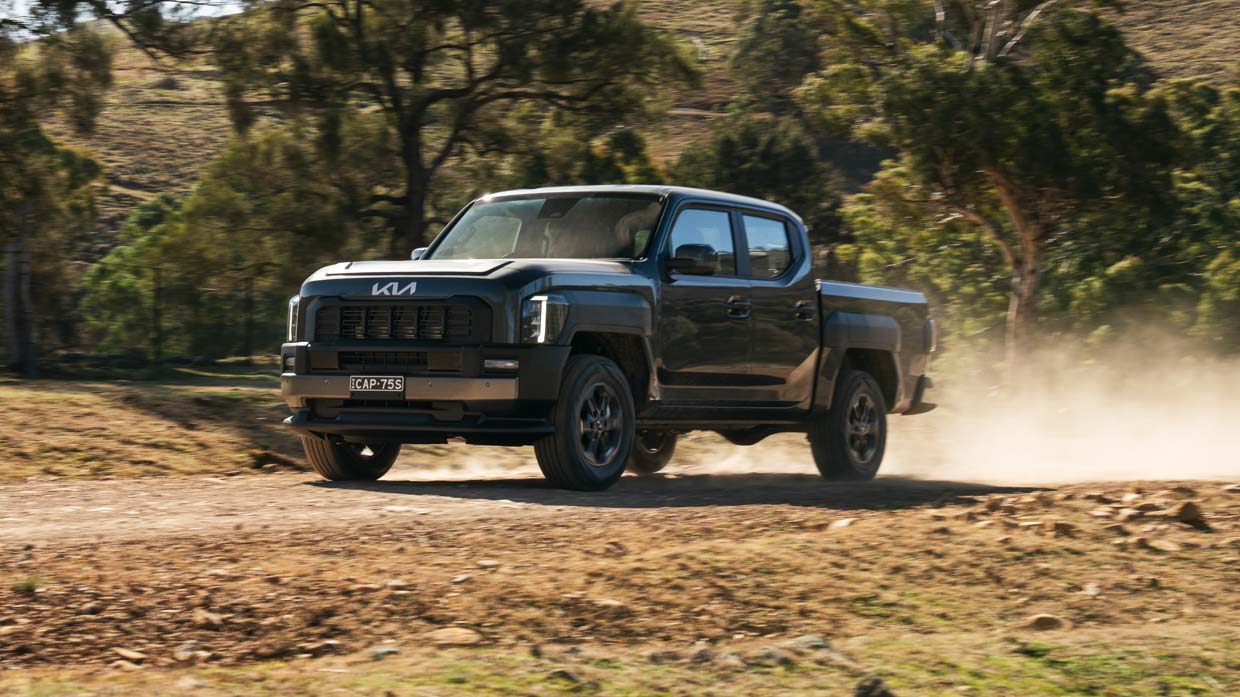
There are only two serious factors that dampen praise: there’s the performance, which is nothing special in a class punctuated by similar four-cylinder diesels…and emerging premium ute powertrains to which Kia has no clear response.
Then there is the styling. That’s subjective — at least the Tasman stands out — but to some, it will be difficult to accept the unusual visual character. We’ll leave that up to you.
Another bugbear might be the price, which is Ranger-adjacent for the most part. But with Kia Australia committing to doing almost anything to hit its self-imposed goal of 20,000 sales per year, expect discounting if the Tasman isn’t hitting targets.
About Chasing cars
Chasing Cars reviews are 100% independent.
Because we are powered by Budget Direct Insurance, we don’t receive advertising or sales revenue from car manufacturers.
We’re truly independent – giving you Australia’s best car reviews.
The estimate provided does not take into account your personal circumstances but is intended to give a general indication of the cost of insurance, in order to obtain a complete quote, please visit www.budgetdirect.com.au. Estimate includes 15%^ online discount.
^Conditions Apply
Budget Direct Insurance arranged by Auto & General Services Pty Ltd ACN 003 617 909(AGS) AFSL 241 411, for and on behalf of the insurer, Auto & General Insurance Company Limited(ABN 42 111 586 353, AFSL 285 571).Because we don’t know your financial needs, we can’t advise you if this insurance will suit you. You should consider your needs and the Product Disclosure Statement before making a decision to buy insurance. Terms and conditions apply.
Indicative quote based on assumptions including postcode , 40 year old male with no offences, licence suspensions or claims in the last 5 years, a NCD Rating 1 and no younger drivers listed. White car, driven up to 10,000kms a year, unfinanced, with no modifications, factory options and/or non-standard accessories, private use only and garaged at night.
^Online Discounts Terms & Conditions
1. Discounts apply to the premium paid for a new Budget Direct Gold Comprehensive Car Insurance, Third Party Property Only or Third Party Property, Fire & Theft Insurance policy initiated online on or after 29 March 2017. Discounts do not apply to optional Roadside Assistance.
2. Discounts do not apply to any renewal offer of insurance.
3. Discounts only apply to the insurance portion of the premium. Discounts are applied before government charges, taxes, levies and fees, including instalment processing fees (as applicable). The full extent of discounts may therefore be impacted.
4. We reserve the right to change the offer without notice.